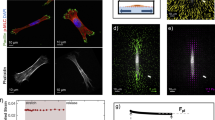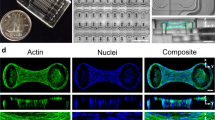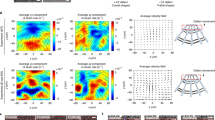Summary
To demonstrate that cells both perceive and respond to external force, a strain/relaxation regimen was applied to normal human fetal and aged dermal fibroblasts cultured as monolayers on flexible membranes. The precisely controlled protocol of stretch (20% elongation of the culture membrane) at 6.67 cycles/min caused a progressive change in the monolayers, such that the original randomly distributed pattern of cells became a symmetric, radial distribution as the cell bodies aligned parallel to the applied force. High cell density interfered with the success of re-alignment in the fetal cell cultures observed, which may reflect a preference in this cell strain for cell-cell over cell-matrix contacts. The chronologically aged cells observed did not demonstrate this feature, aligning efficiently at all seeding densities examined. The role of microfilaments in force perception and transmission was investigated through the addition of cytochalasin D in graded doses. Both intercellular interactions and cytoskeletal integrity mediate the morphological response to mechanical strain.
Similar content being viewed by others
References
Banes, A. J.; Link, G. W.; Bevin, A., et al. Tendon synovial cells secrete fibronectin in vivo and in vitro. J. Orthop. Res. 6:73–82; 1988.
Banes, A. J.; Link, G. W.; Gilbert, J. W., et al. Culturing cells in a mechanically active environment. Am. Biotechnol. Lab. 8:12–22; 1990.
Brunette, D. M. Mechanical stretching increases the number of epithelial cells synthesizing DNA in culture. J. Cell Sci. 69:35–45; 1984.
Buckley, M. J.; Banes, A. J.; Jordan, R. Effects of mechanical strain on osteoblasts in vitro. J. Oral Maxillofac. Surg. 48:276–282; 1990.
Buckley, M. J.; Banes, A. J.; Levin, L. G., et al. Osteoblasts increase their rate of division and align in response to cyclic, mechanical tension in vitro. Bone Miner. 4:225–236; 1988.
Cooper, J. A. Effects of cytochalasin and phalloidin on actin. J. Cell Biol. 105:1473–1478; 1987.
Dartsch, P. C.; Hammerle, H. Orientation response of arterial smooth muscle cells to mechanical stimulation. Eur. J. Cell Biol. 41:339–346; 1986.
Flickinger, K. S.; Carter, W. G.; Culp, L. A. Deficiency in integrin-mediated transmembrane signaling and microfilament stress fiber formation by aging dermal fibroblasts from normal and Down’s syndrome patients. Exp. Cell Res. 203:466–475; 1992.
Ingber, D. E. The riddle of morphogenesis: a question of solution chemistry or molecular cell engineering. Cell 75:1249–1252; 1993.
Ives, C. L.; Eskin, S. G.; McIntire, L. V. Mechanical effects on endothelial cell morphology: in vitro assessment. In Vitro Cell Devel. Biol. 22:500–507; 1986.
Janmey, P. A.; Hvidt, S.; Oster, G. F., et al. Effect of ATP on actin filament stiffness. Nature 347:95–99; 1990.
Komuro, I.; Katoh, Y.; Kaida, T., et al. Mechanical loading stimulates cell hypertrophy and specific gene expression in cultured rat cardiac myocytes. J. Biol. Chem. 266:1265–1268; 1991.
Levesque, M. J.; Nerem, R. M. The elongation and orientation of cultured endothelial cells in response to shear stress. J. Biomech. Eng. 176:341–347; 1985.
Norwood, T.; Smith, J.; Stein, G. H. Aging at the cellular level: the human fibroblast cell model. In: Schneider, E. L.; Rowe, J. W., eds. Handbook of the biology of aging. San Diego: Academic Press; 1990:131–154.
Rittling, S. R.; Brooks, K. M.; Cristofalo, V. J., et al. Expression of cell cycle-dependent genes in young and senescent WI-38 fibroblasts. Proc. Natl. Acad. Sci. USA 83:3316–3320; 1986.
Shirinsky, V. P.; Antonov, A. S.; Birukov, K. G., et al. Mechano-chemical control of human endothelial orientation and size. J. Cell Biol. 109:331–339; 1989.
Thweatt, R.; Murano, S.; Fleischmann, R. D., et al. Isolation and characterization of gene sequences overexpressed in Werner syndrome fibroblasts during premature replicative senescence. Exp. Gerontol. 27:433–440; 1992.
Tran-Son-Tay, R. Techniques for studying the effects of physical forces on mammalian cells and measuring cell mechanical properties. In: Frangos, J. A., ed. Physical forces and the mammalian cell. New York: Harcourt Brace Jovanovich; 1993:1–59.
Vandenburgh, H. H. Dynamic mechanical orientation of skeletal myofibers in vitro. Dev. Biol. 93: -; 1982.
Vandenburgh, H. Mechanical forces and their second messengers in stimulating cell growth in vitro. Am. J. Physiol. 262:R350-R355; 1992.
Wang, N.; Butler, J. P.; Ingber, D. E. Mechanotransduction across the cell surface and through the cytoskeleton. Science 260:1124–1127; 1993.
Author information
Authors and Affiliations
Rights and permissions
About this article
Cite this article
Grymes, R.A., Sawyer, C. A novel culture morphology resulting from applied mechanical strain. In Vitro Cell.Dev.Biol.-Animal 33, 392–397 (1997). https://doi.org/10.1007/s11626-997-0011-8
Issue Date:
DOI: https://doi.org/10.1007/s11626-997-0011-8




